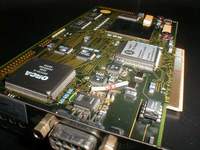

|
About TNet |
 |
|
Background The TNet hardware
consists of 32bit as well as 64bit PCI network interface cards and
intelligent, destination routed switches interconnected by Fiber
channel technology. A NIC firmware, a TNet driver and the Fast Communication
Interface (FCI) together form the basic software to run message
passing oriented applications. On the Swiss-Tx cluster, job management
is done by Gridware’s Codine that is interacting with Cosmos, a
process control service for TNet by SCS. The concepts of TNet go
back to SCS’s Remote Store Architecture technology, a technique
that enables a direct store from one processor into the memory of
another processor. It is the long research and experience of SCS
on parallel computing that characterizes the high quality of this
product. |
|
|
Fundamentals Address translation is done on multiple levels (PCI-Bus, Network, etc.) for a remote store. The important part is, that the network card can map the host memory to the network in form of Virtual Communication Addresses. The example above describes the situation after the target has sent a request to get a message to the initiator. This mechanism allows the target’s NIC to handle the incoming data and place it at the right memory spot in the host. TNet has been
designed for large-scale clusters. Each NIC is addressed by a
16bit destination ID which gives a total of 65536 nodes possible.
The actual network bandwidth is 1Gbit/s and will be multiplied
on future TNet releases. Switches are remotely configurable and
allow any network topology by preventing deadlocks. The 12 port
full crossbar switches, which in contrast to Myrinet use destination
routing, also include monitoring of the network performance. Variable
size micropackets of maximal 128 bytes permit a fair access even
on a highly loaded network. Reliability is improved by a hardware
implemented retransmission protocol. |
|